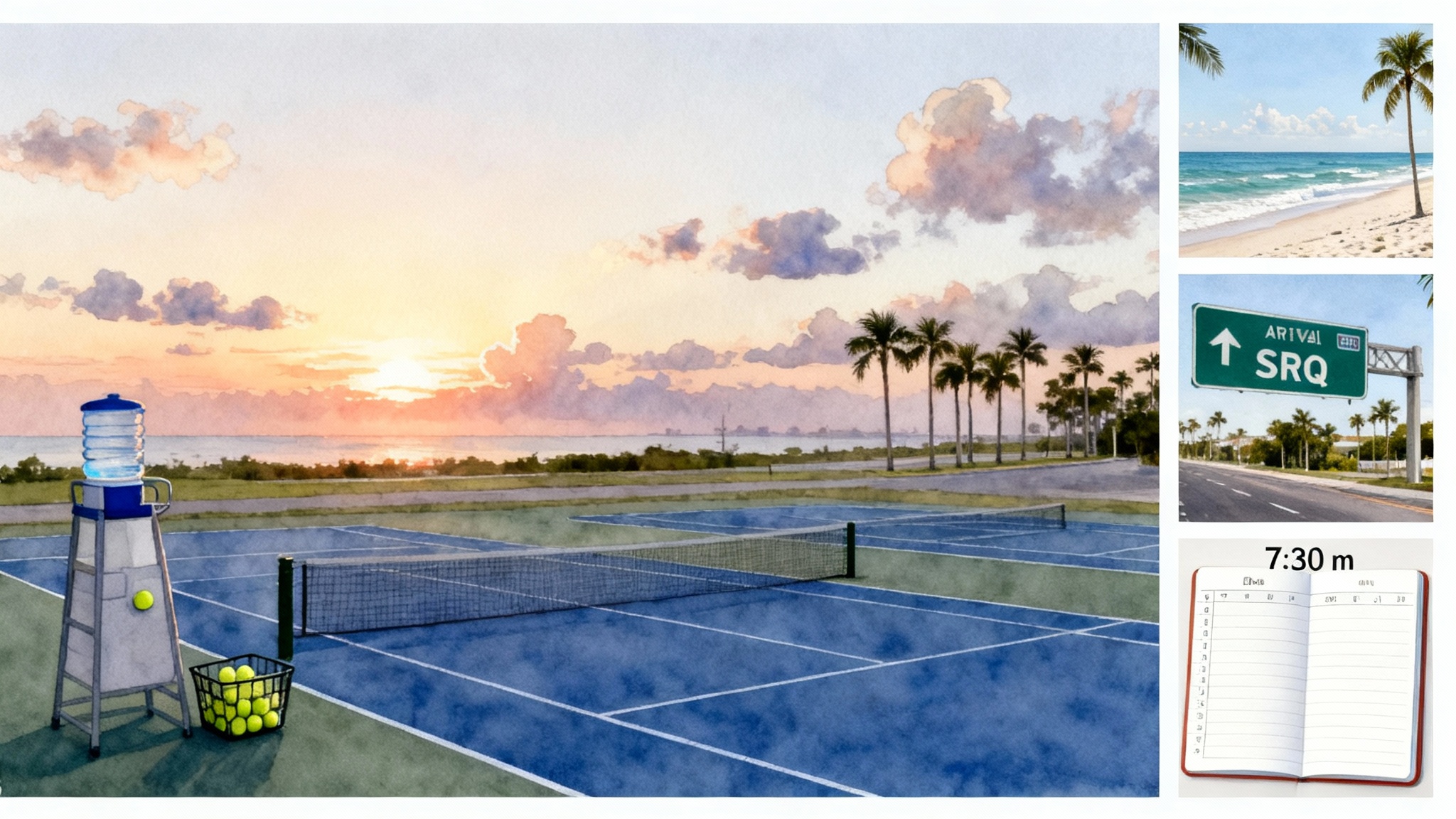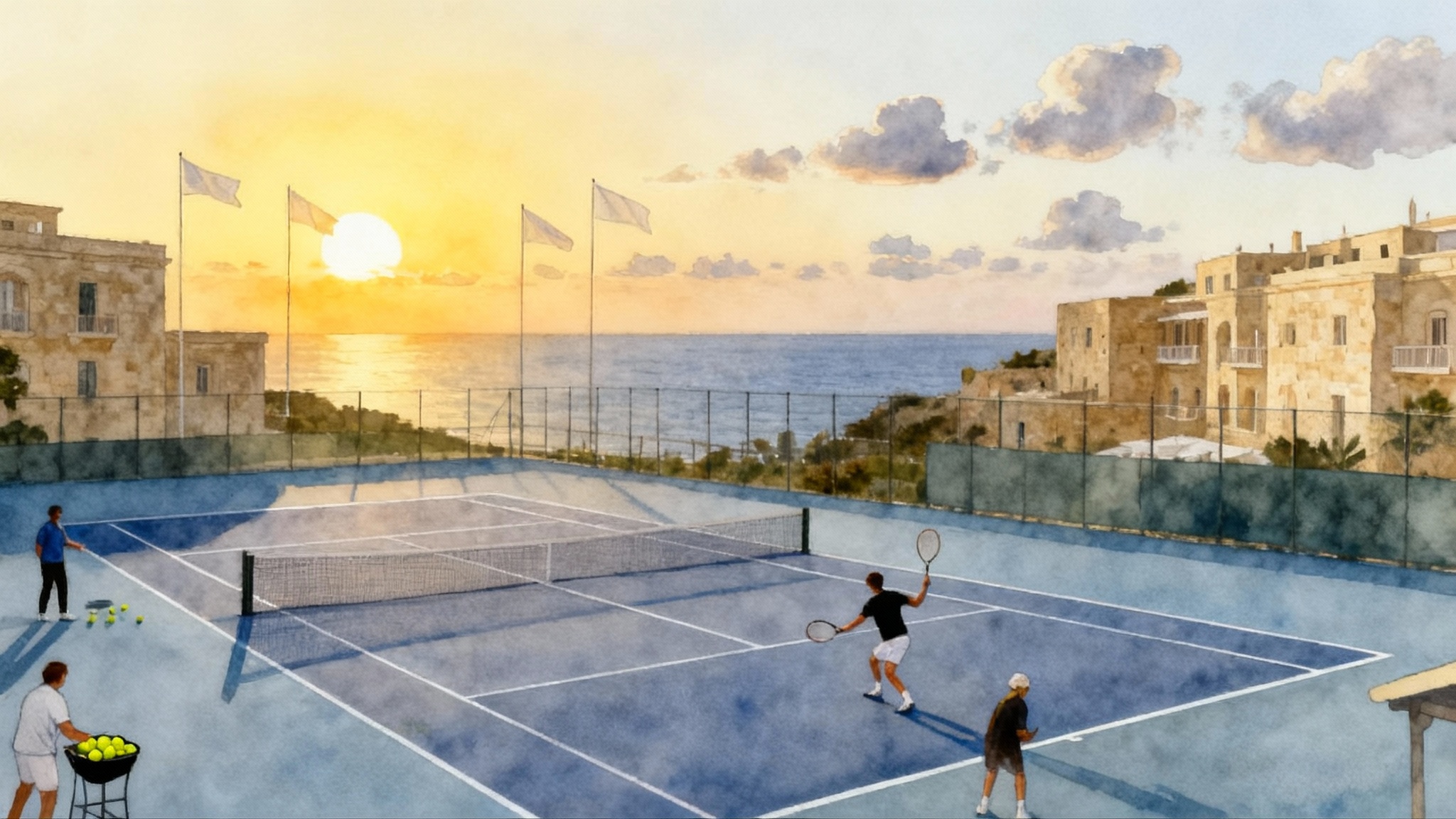Sarasota Florida Tennis 2025–26: Winter Spring Training Guide
Plan a climate-smart, logistics-first week on Florida’s Gulf Coast. Compare Sarasota with Miami, Naples, and Orlando for November to April training, then follow a detailed playbook around Celsius Tennis Academy’s new hard-court base.

Why Sarasota is the winter-spring sweet spot
When your goal is a reliable block of training between November and April, the Gulf Coast checks boxes that players often overlook until something goes wrong. Sarasota sits in Florida’s dry season, yet keeps the moderating benefits of the Gulf. Mornings are typically calmer, afternoons see a predictable sea breeze, and humidity runs lower than the summer months. That pattern matters on court. It means more playable hours with fewer last-minute scrambles and less guesswork for coaches.
The logistics also favor productivity. Sarasota Bradenton International Airport, airport code SRQ, gets you into town in minutes, not hours. Courts cluster within short drives, beach recovery is close, and you can still reach Tampa Bay or Fort Myers for matches without losing a day in the car.
This guide compares Sarasota with Miami, Naples, and Orlando on four training variables that move the needle: rain days, wind, ultraviolet exposure, and court inventory. It then builds a one-week blueprint centered on the Celsius Tennis Academy profile at the Boys and Girls Clubs campus, complete with morning on-court blocks, beach-based recovery, Universal Tennis Rating match play, college-visit options, price bands, court-booking tactics, flight choices, places to stay, and rainy-day or heat-management backups.
If you prefer ultra-dry desert conditions for an alternate block, see our Indian Wells desert tennis guide.
Sarasota vs. Miami, Naples, and Orlando: what changes on court
Here is how the winter-spring window looks when you translate climate and infrastructure into tennis outcomes.
-
Training reliability
- Sarasota and Naples: Dry-season mornings are your best friend. Expect more “go” days before noon, with most weather-induced pauses tied to quick-moving fronts rather than long soakers. Naples is a touch warmer; Sarasota earns back minutes with easier inter-neighborhood travel.
- Miami: Warmer overall but often breezier near the coast and more variable with passing showers. Great for heat acclimation; less ideal if you want repetition at the same time each day.
- Orlando: Farther inland, a degree cooler on some winter mornings and subject to sharper temperature swings when fronts pass. Travel across the metro can eat time.
-
Wind
- Sarasota and Naples: The sea breeze typically builds after late morning. Plan live-ball and serve sets early; use the breeze for pattern training later. Sheltered facilities help, but morning remains the sweet spot.
- Miami: Coastal exposure means more frequent moderate winds. Good for resilience training, harder for precise technical work.
- Orlando: Frontal days can be gustier; non-frontal days can be calm. Variability is the theme.
-
Ultraviolet exposure
- Everywhere in Florida, the midday sun is real even in winter. Sarasota’s pattern rewards early starts. Spring UV rises by March; hats, long sleeves, and between-change sunscreen become non-negotiable. Plan tactical classroom time during peak UV hours.
-
Court inventory and cost
- Sarasota: A practical mix of public hard courts, club options with guest passes, and academy access. You can assemble a reliable weekly schedule without driving 45 minutes each way.
- Miami: More total courts, but demand is fierce and prices trend higher. Booking windows matter.
- Naples: Private-club heavy. Beautiful facilities; you will need relationships or guest policies.
- Orlando: Abundant public options spread widely; travel time becomes the friction.
Bottom line: Sarasota gives you a high probability of stacking productive mornings with predictable afternoons during the November to April window, and it does so without punishing commutes.
Home base: Celsius Tennis Academy at the Boys and Girls Clubs campus
Celsius Tennis Academy has established its new hard-court base at the Boys and Girls Clubs campus in Sarasota, creating a simple, athlete-first hub. The setup focuses on what winter and spring players need: clean bounces, reliable lighting, and enough courts to run technical blocks, live-ball patterns, and serve plus first-ball sessions without shuffling across town.
What that means for your week:
- Centralized mornings: Start early, finish before sea breeze and UV peak.
- Seamless transition to recovery: Beach access and food options within a short drive allow you to control post-session inputs.
- Afternoon match play: A direct pipeline to Universal Tennis Rating competition most days within an hour’s radius. You can use the UTR events calendar to align level and goals.
A one-week Sarasota blueprint
The plan below assumes a Sunday arrival and Saturday departure. Adjust by swapping the recovery day if your tournament falls midweek.
-
Sunday
- Travel and light movement
- 30 minutes mobility and band work
- 60 minutes easy hit or shadow swings at sunset
- Brief planning huddle: goals for the week, key patterns to emphasize
-
Monday
- 7:30 a.m.–10:00 a.m. core block at Celsius base: tempo warm-up, two technical priorities, serve plus first ball, plus one competitive drill
- 10:30 a.m.–11:30 a.m. beach recovery at Lido or Siesta: 10 minutes water walk, 10 minutes diaphragmatic breathing, 10 minutes light hip work in the shallows
- 1:30 p.m.–3:30 p.m. Universal Tennis Rating practice sets or verified match play; alternate courts if needed
- 4:00 p.m. 25-minute video review and note capture
-
Tuesday
- 7:30 a.m.–10:00 a.m. live-ball plus transition patterns; short court to long court progressions
- 10:30 a.m. protein-focused lunch and hydration checkpoint
- 2:00 p.m.–3:30 p.m. structured point play on target serves; two tiebreakers to finish
- 4:30 p.m. 30-minute strength block: split squats, anti-rotation, carries; end with 8-minute mobility
-
Wednesday
- 8:00 a.m.–10:30 a.m. serve day with second-serve spin focus; return plus depth lanes
- Noon college tie-in: campus visit or open practice where available
- 3:00 p.m. recovery spin or beach walk; 15 minutes of contrast water if conditions allow
-
Thursday
- 7:30 a.m.–10:00 a.m. pattern day: cross to line, inside-out to inside-in, transition ball checkpoints
- 1:30 p.m.–4:30 p.m. UTR match play or verified practice matches
- Evening optional scouting: brief clip study on the next opponent’s tendencies
-
Friday
- 8:00 a.m.–10:30 a.m. pressure sets: 30–30 starts, no-ad games, extended tiebreaks
- 11:15 a.m. team lunch and week recap; note major gains and one carry-forward priority
- 2:00 p.m. off-feet recovery and light mobility
-
Saturday
- If competing: match day routine
- If traveling: 45 minutes movement in the morning, then depart
Why this cadence works
- Mornings exploit calmer air and lower UV, lifting technical work quality.
- Beach recovery in cooler water reduces lower-leg soreness and encourages relaxed diaphragmatic breathing after high-intensity sets.
- Afternoon UTR play adds the unpredictability that training cannot replicate without tipping the weekly load too far.
College-visit tie-ins within striking distance
Use Sarasota as a hub to learn what college-level tennis looks like. Call ahead for practice viewing or campus tours.
- Tampa and St. Petersburg, about one hour north: University of South Florida, University of Tampa, Eckerd College
- Lakeland, about ninety minutes: Florida Southern College
- Fort Myers, under two hours south: Florida Gulf Coast University
The aim is not a recruiting trip; it is an education. Watch a practice block, note the tempo and standards, then bring one idea back to Friday’s pressure sets.
Price bands and how to budget
These ranges reflect typical winter and spring conditions in Sarasota. Your actual numbers will vary with program intensity and accommodation preferences, but these brackets allow you to build a realistic plan.
-
Coaching and court time
- Private lesson: 100 to 160 dollars per hour
- Small-group session: 40 to 80 dollars per player per hour
- Academy day rate, when offered: 120 to 220 dollars per player
- Public hard-court rental: 5 to 20 dollars per player for two hours; 10 to 25 dollars with lights
-
Match play and tournaments
- Universal Tennis Rating verified match fees or local events: 25 to 60 dollars per player per day
-
Accommodation
- Mid-range hotel near the campus or downtown: 160 to 280 dollars per night
- Beachside hotel on Lido or Siesta: 240 to 420 dollars per night
- Two-bedroom vacation rental within a short drive: 180 to 320 dollars per night, plus cleaning and taxes
-
Flights and transport
- Roundtrip into Sarasota Bradenton International Airport: 220 to 520 dollars from major hubs in winter; holidays trend higher
- Roundtrip into Tampa International Airport: 180 to 460 dollars; add a car and highway tolls
- Car rental: 40 to 70 dollars per day; add 15 to 30 dollars for a weekly SunPass or toll package if you prefer automatic billing
-
Recovery and extras
- Strength session with a local coach: 60 to 100 dollars per hour
- Sports massage: 90 to 140 dollars per hour
Budget tip: Lock morning courts first, then layer match play. You can flex recovery and gym work around confirmed hitting.
Court-booking tactics that actually work
-
Book the mornings
Target 7:30 a.m. to 9:30 a.m. or 8:00 a.m. to 10:00 a.m. Start on time and finish before sea breeze and UV peak. Your afternoon block stays flexible for UTR matches. -
Hold a backup court
Reserve a secondary court within 10 to 15 minutes of your main base. If the primary session runs long or a last-minute match becomes available, you avoid dead time. -
Use public plus partner mix
Combine public courts for technical blocks with guest passes at private facilities for match play. The variety helps footwork and vision while spreading cost. -
Read the booking windows
Many public facilities release courts on a 3 to 7 day cycle. Set calendar alerts. Peak demand days are Monday and Thursday mornings; act as soon as the window opens. -
Group size and timing
For four players, preassign two new balls per court and a clear drill order. For six to eight, set up two stations and swap every 20 minutes to keep quality high.
Flights and getting there: SRQ vs TPA
-
SRQ, Sarasota Bradenton International Airport
Five to fifteen minutes to central Sarasota, depending on where you stay. Nonstops vary seasonally; confirm routes before you lock accommodations. Reference the airport’s official route information via SRQ nonstop routes. -
TPA, Tampa International Airport
About one hour to Sarasota outside rush hour. Expect tolls on the route across Tampa Bay. TPA has deep airline coverage and competitive fares; the drive is simple if you plan around peak traffic. If you fly into TPA for late arrival, consider staying near the airport and driving down early, then start your week fully rested. -
Ground rules for cars
Book a midsize vehicle that fits four racquets and a roller. Add a small cooler for ice and drinks. Program your navigation with two court sites and one beach spot before you land.
Where to stay near the Boys and Girls Clubs campus
Choose a base within 10 to 15 minutes of the courts. You will guard your mornings, recover better, and spend less.
-
Rosemary District and Downtown Sarasota
Walkable, with coffee and food options you can use between sessions. Hotels include business-friendly suites with kitchenettes and rooftop pools. Expect 180 to 300 dollars per night in winter. -
Arlington Park and the Fruitville corridor
Quick access to courts and major roads. Value-forward hotels, townhomes, and family rentals. Expect 160 to 260 dollars per night. -
Indian Beach and Sapphire Shores
Quiet neighborhoods closer to the water. Mix of boutique inns and rentals. Plan a few extra minutes of drive time at school pickup hours. -
Lido Key and Siesta Key
Best for teams that prioritize beach recovery. Higher rates in peak months. Budget the commute and parking into your schedule.
Wherever you stay, confirm on-site laundry or a drop-off service. Fresh gear increases training quality late in the week.
Rainy-day and heat-management backups
A strong week includes contingencies. Build them in from the start.
-
If light rain threatens
Slide the start to 9:00 a.m. and shorten changeovers. Keep a towel in your non-hitting hand to maintain a dry grip. Use new balls after any damp interval. -
If a morning is washed out
Move inside for a 60-minute film session: your previous match highlights, two specific pro points that mirror your targets, and a whiteboard plan for the rescheduled set.
Shift a recovery run to the beach late afternoon when surfaces dry. Use a 20-minute sand walk for ankles and feet. -
If heat or UV spikes
Adjust to a split day: 7:00 a.m.–8:45 a.m. on court, 11:30 a.m. classroom, 3:30 p.m.–5:00 p.m. on court. Use ice towels every changeover and 500 to 700 milliliters of fluid per hour, with electrolytes. -
Grip and string management
Rotate overgrips every session in humidity. If you play polyester, drop tension 2 to 3 pounds for morning cool and add 1 pound for warmer afternoons. Keep a backup racquet prepped both ways.
For a fully indoor fallback model in a cooler climate, see our Seattle-Vancouver indoor corridor guide.
Equipment and packing checklist
-
Sun and heat
Wide-brim hat, lightweight long-sleeve shirt, sunglasses with wrap coverage, zinc sunscreen, and a cooling towel. -
Court efficiency
Two racquets strung within 48 hours of the trip, plus one older backup. Five sleeves of extra balls for technical work. A small cone set and a resistance band. -
Recovery
Flip-flops for beach entries, collapsible foam roller, lacrosse ball, and a compact first-aid kit with blister care. -
Food and hydration
24 to 32 ounce insulated bottle, electrolyte packets, and two quick-digest snacks per session.
Putting it all together
Sarasota offers the training rhythm most winter and spring players chase but rarely find. You get calm, playable mornings; a compact web of courts; and a short hop to beach recovery that actually restores you for the next block. Plan match play through Universal Tennis Rating, lock the first ninety minutes of each morning, and protect the middle of the day for recovery and review. Back it all up with two court reservations, a realistic flight plan into SRQ or TPA, and accommodation within a short drive of the Boys and Girls Clubs campus.
If you design the week with those constraints in mind, Sarasota becomes more than a warm-weather destination. It becomes a reliable system that converts travel into training momentum, day after day, until you board your flight home with sharper patterns, tougher decision-making, and a body that still wants to play.








